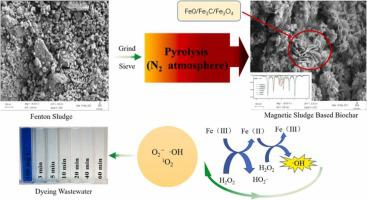Journal of Environmental Chemical Engineering ( IF 7.4 ) Pub Date : 2022-01-21 , DOI: 10.1016/j.jece.2022.107242 Guirong Ye 1, 2 , Jinghong Zhou 1 , Renting Huang 1 , Yingjun Ke 1 , Yecan Peng 1 , Yongxin Zhou 2 , Yu Weng 1 , Chutong Ling 1 , Weixi Pan 1

|
Fenton sludge was converted into magnetic sludge-based biochar (SMBC) using a one-step pyrolysis process and employed as a novel heterogeneous catalyst to activate hydrogen peroxide (H2O2) for the oxidative removal of methylene blue (MB). The crystal structure and catalytic activity of SMBC are strongly affected by the pyrolysis temperature. X-ray powder diffraction, Mössbauer, and scanning electron microscope-energy dispersive spectrometer analyses were conducted to determine the crystal phase transfer of iron (Fe) oxides at different pyrolytic temperatures and retention times. The results revealed that the catalytic efficiency of SMBC was strongly related to the crystal phase of Fe oxides. The catalyst obtained at 800 °C for 1 h exhibited superior catalytic properties and degraded 98.56% of the MB (100 mg·L−1) in 3 min via the synergistic effect of Fe3O4, Fe0, and biochar. Free radical quenching experiments and electron paramagnetic resonance studies demonstrated that ·OH, and 1O2 participated in the H2O2 system, and·OH radicals were promptly generated owing to the catalysis of the SMBC. Aging tests were repeated for four cycles in three conditions to examine the stability of the material. The results showed that SMBC was relatively stable in non-aerated and aqueous conditions, but its activation performance was severely inhibited in an oxygen environment. Furthermore, the catalytic ability of SMBC was maintained at 88.13% after the 4th run. This study presents a cost-effective method of converting ferric sludge to an environmentally friendly catalyst that enables H2O2 activation for degrading refractory organic contaminants.
中文翻译:

芬顿污泥衍生的磁性污泥基生物炭作为高效非均相芬顿催化剂降解亚甲蓝
芬顿污泥通过一步热解工艺转化为磁性污泥基生物炭(SMBC),并用作新型多相催化剂活化过氧化氢(H 2 O 2) 用于氧化去除亚甲蓝 (MB)。SMBC的晶体结构和催化活性受热解温度的影响很大。进行 X 射线粉末衍射、穆斯堡尔分析和扫描电子显微镜-能量色散光谱仪分析以确定铁 (Fe) 氧化物在不同热解温度和保留时间下的晶相转移。结果表明,SMBC的催化效率与Fe氧化物的晶相密切相关。通过Fe 3 O 4、Fe 0的协同作用,在800 ℃下1 h得到的催化剂表现出优异的催化性能,并在3 min内降解了98.56%的MB(100 mg·L -1 )。, 和 biochar。自由基猝灭实验和电子顺磁共振研究表明·OH、1 O 2参与H 2 O 2体系,在SMBC的催化作用下迅速生成·OH自由基。在三种条件下重复老化测试四个循环,以检查材料的稳定性。结果表明,SMBC在非充气和含水条件下相对稳定,但在氧气环境下其活化性能受到严重抑制。此外,在第 4 次运行后,SMBC 的催化能力保持在 88.13%。本研究提出了一种将含铁污泥转化为环境友好型催化剂的经济有效的方法,该催化剂能够活化 H 2 O 2以降解难降解的有机污染物。









































 京公网安备 11010802027423号
京公网安备 11010802027423号